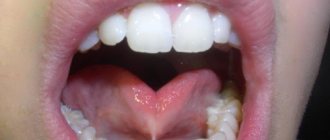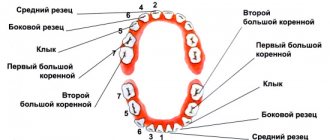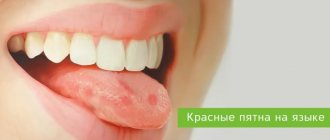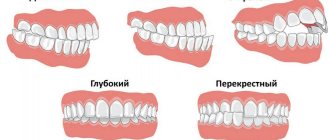Quick transition Treatment of a short frenulum of the tongue
A short frenulum of the tongue (ankyloglossia) is one of the most common minor anomalies in the development of the oral cavity.
The frenulum of the tongue is a fold of the oral mucosa that runs along the midline and connects the floor of the mouth with the lower surface of the tongue.
The function of the tongue frenulum is to fix the tongue to the soft tissues of the oral cavity, preventing tongue retraction (glossoptosis), especially during the neonatal period.
Symptoms
When crying, the tip of the baby's tongue bifurcates in the shape of a stylized heart.
The baby cannot stick his tongue out of his mouth. To test this reflex, you can run your finger over the baby's lips. Normally, the baby sticks his tongue out quite far, moving it around his lips in search of mother's milk.
Breastfeeding takes a lot of time, the baby is capricious, nervous, and clicking sounds are heard when sucking.
The baby is not gaining weight well.
A child with a short frenulum cannot reach the palate with his tongue.
There is a noticeable disturbance in the pronunciation of certain sounds during speech formation.
With a short frenulum (less than 1.5 cm), if it is attached to the soft tissues of the floor of the mouth, functional disorders do not always occur. These include difficulty sucking during breastfeeding and disturbances in sound pronunciation during the formation of phrasal speech.
Reasons for appearance
Reasons for education:
- lack of nutrients, iron and vitamin PP in the patient’s body;
- anemia;
- lack of B vitamins;
- allergic reaction to toothpaste or medications;
- chronic fatigue and constant nervous tension;
- mechanical damage to the tongue (nervous biting, chewing);
- disruption of capillary blood flow in the tongue;
- the patient has diseases such as gastritis, enterocolitis, hepatitis, cholecystitis;
- wearing uncomfortable dentures.
The main reason why the tongue is cracked is mechanical injuries due to a lack of vitamins and microelements in the patient’s body. In this case, it is enough to bite your tongue while chewing food so that a painful crack forms at its tip.
Another fairly common reason why a patient’s tongue is cracked is a malfunction in the patient’s central nervous system, which is caused by chronic fatigue, frequent stress, and lack of sleep. This is a reason to suspect a problem with the hypothalamus.
It happens that patients are perplexed: why there are cracks on the tongue, there seems to be no visible reason for their appearance. In this case, the answer to the question of why cracks appear can only be given by an experienced doctor, after a thorough diagnosis. It is necessary to do a detailed blood test to determine which microelements and vitamins are missing in the patient’s body. Quite often, correction of the nutritional system helps get rid of the disease.
Many people are probably interested in the question of what cracks mean. After all, the tongue, as is known, signals the presence of many diseases and pathological conditions of the human body. Cracks in the tongue are a sign of a lack of vitamins and microelements in the body. Quite often, cracks are caused by worms, as they deplete the human body, causing anemia and iron deficiency. They also indicate a diseased liver, since with this disease the human body does not receive many microelements important for health.
Cracks in the tongue on the side can be a sign of thyroid disease; in this case, it swells and is injured at the edges by the patient’s teeth.
Consequences of frenulum anomaly
Hypotrophy due to impaired sucking, poor weight gain in infants.
Malocclusion, the first signs of which during the period of temporary occlusion is the rotation of the central lower incisors to the lingual side.
Impaired development of the lower jaw, as a result, the formation of a distal bite.
Local gingivitis, periodontitis up to exposure of the roots of the teeth in the area of the lower jaw incisors.
Violation of the pronunciation of sounds that require raising the tongue upward: “sh”, “zh”, “sch”.
Impaired language development due to asymmetrical growth. Low mobility of the tongue impairs the articulation of some sounds. Violation of diction (clarity, intelligibility of pronunciation).
What it is
Officially, painful cracks on the tongue and along the edge of the tongue are called glossalgia. This is a fairly common neurosomatic disease.
Most common symptoms:
- dryness in the tongue area;
- itching and burning;
- swelling;
- soreness.
The insidiousness of glossalgia is that it does not go away on its own; without appropriate treatment it is impossible to get rid of a crack in the tongue.
At an early stage of the disease, the doctor may not notice pronounced cracks in the tongue, since they are microscopic and mainly manifest themselves as burning and pain. If you do not respond to this symptom in a timely manner, over time a crack may form at the tip or in the middle of the tongue, longitudinally, as well as cracks under the tongue and on the sides. In this case, the doctor also notes swelling and swelling of the tongue, atrophy of the salivary glands and filiform papillae on the surface of the tongue. The sooner you start treatment, the easier it is to get rid of glossalgia, so if you have cracks in your tongue, you should immediately consult a doctor.
Treatment methods
In the event that the folding of the tongue began to form in a child when he was still in the womb, it is possible to talk about any treatment, and especially surgical intervention, only from the age of 5 years. The pediatrician refers the small patient to a pediatric dentist, who prescribes therapeutic procedures, including preventive treatment of the oral cavity with antiseptic agents.
If the pathology manifests itself as a consequence of certain disturbances in the functioning of the internal systems of the body, for example, cardiovascular, endocrine or digestive, treatment should be aimed at eradicating the root cause of the problem. As part of symptomatic therapy, experts prescribe:
- immunomodulatory drugs,
- rinsing and treating the oral cavity with anti-inflammatory and antibacterial solutions; decoctions and infusions of medicinal herbs can be prescribed,
- complete sanitation – elimination of all dental diseases, including caries and inflammation of various etiologies.
Rinsing with medicinal herbs will help in treatment.
To solve the aesthetic problem, a laser is actively used today, which, as it were, evaporates and at the same time helps to smooth out overgrown tissue. As a result, the organ noticeably decreases in size, and its surface is leveled. The surgical method is extremely rarely used to correct a folded tongue, and it consists of suturing the grooves.
Congenital pathologies of the tongue and frenulum - types and features
Anomalies of the tongue can be either congenital or acquired; they are often the result of certain pathological processes occurring in the body. Currently, malformations of the main speaking organ are quite rare. Many of them are serious problems that often require surgery. Further in this article we will talk about what congenital defects of the tongue and frenulum exist, how they are corrected, and also consider in detail such a pathology as a folded tongue.
Prevention
To prevent the development of such a disease, you need to follow some simple preventive rules:
- Promptly treat all diseases that provoke the development of pathology.
- Do not abuse alcoholic beverages, tobacco products, sweet foods and sugar, and strong coffee.
- Take enough vitamins to avoid vitamin deficiency.
- Perform hygiene .
- Treat caries in a timely manner.
There are separate preventive measures for children:
Caring for baby teeth – timely treatment and removal of baby teeth. If a child complains of dry mouth, rinse with herbs such as sage, St. John's wort or chamomile.
Brushing your teeth should be done only with toothpastes, since the powders contain mint oil and menthol, which are bad for the oral mucosa in children.
Glossitis
Folded glossitis
A folded tongue may be a normal variant or a manifestation of mutations in the genetic apparatus.
There is a high probability of this anomaly occurring in congenital pathologies of the central nervous system (Down's disease). A distinctive feature of the folded tongue are longitudinal and transverse folds. In this case, the longitudinal fold runs strictly along the midline of the tongue - from its tip to the root. Often a folded tongue is combined with macroglossitis (enlarged tongue) and areas of scaly peeling of the tongue.
Patients usually do not complain, but pay attention to the unusual appearance of the tongue. If atrophy of the tongue papillae is present, complaints of burning and loss of taste are possible. Bad breath often occurs due to food getting into the folds.
A folded tongue may be part of a set of symptoms when:
- acute gastritis;
- hypovitaminosis B;
- diabetes mellitus in combination with candidiasis;
- osteochondrosis of the cervical spine.
Atrophic glossitis
An inflammatory process of the mucous membrane of the tongue, which is accompanied by a decrease in the size of its papillae or their disappearance. As a result, the surface of the back of the tongue becomes red, smooth and shiny. Atrophic processes affect all tissues of the tongue, as a result of which its thickness decreases.
As the muscle volume of the tongue decreases, swelling and ulceration appear. The patient complains of a change in taste perception. soreness and bad breath.
Atrophic glossitis develops when:
- blood anemia (iron deficiency, B12 deficiency);
- hypovitaminosis (riboflavin - vitamin A, nicotinic acid - vitamin PP);
- streptococcal and fungal infections;
- HIV infections.
Hypoplastic glossitis
Damage to the mucous membrane of the tongue, which develops due to diseases of the gastrointestinal tract and lack of vitamins B2 (riboflavin) and PP (nicotinic acid). It is characterized by a decrease or disappearance of the papillae of the tongue, so the tongue has a “varnished” appearance, with bright spots and stripes.
If the absorption of vitamins B2 and PP in the intestine is impaired, unpleasant sensations occur: burning, tingling and pain in the tongue when eating.
Exfoliative glossitis
An inflammatory-dystrophic disease of the mucous membrane of the tongue, the etiology (cause) of which has not yet been definitively established. First described as "geographic tongue" and "benign migratory glossitis". Occurs in diseases of the gastrointestinal tract, helminthic infestations, a tendency to allergies and menopause. It is believed that hereditary factors and infectious diseases play a role in the development of the disease.
Exfoliative glossitis is characterized by the periodic appearance and disappearance of round or irregularly shaped red areas of epithelial exfoliation on the back of the tongue and lateral surfaces, surrounded by a bright rim. The exposed areas quickly restore their structure and appear elsewhere on the tongue.
These peelings do not bother the patient, but if the desquamation intensifies, a burning, tingling, tingling sensation appears, especially while eating. The tongue reacts to spicy and spicy foods, hot foods, and is easily infected due to the large area of exposed mucous membrane, which is devoid of protective properties.
Ulcerative glossitis
This pathology of the tongue occurs with infectious lesions of the mucous membrane, as well as common severe somatic diseases. It is characterized by the formation of ulcerative and erosive-ulcerative elements on various surfaces of the tongue, which occur with a pronounced pain symptom, significant dysfunction of the tongue (swallowing, chewing, speech), regional enlargement of the lymph nodes and symptoms of general intoxication of the body (malaise, headache, fever ).
In clinical practice, ulcerative glossitis occurs in the following conditions.
- Diseases of the cardiovascular system.
Decompensated course of hypertension, decompensated heart valve defects, large-focal myocardial infarction. Ulcers appear on the bluish surface of the tip and the anterior third of the tongue, along the midline.
- Chronic gastrointestinal diseases.
In this case, against the background of an ash-gray coating, painful ulcers form on the root of the tongue.
- Blood diseases.
Acute leukemia, aplastic anemia. Ulcerative-necrotic formations are located over the entire surface of the tongue.
- Behçet's disease.
Systemic disease of the mucous membranes of the body of unknown etiology. Multiple, painful aphthae and ulcers appear on the tongue.
- Incorrect prosthetics.
Bright red erosions and ulcers are located on the lateral surfaces of the tongue.
Villous glossitis
A chronic disease of the mucous membrane of the tongue, which is characterized by the proliferation of filiform papillae with their subsequent keratinization. This is predisposed to:
- diseases of the gastrointestinal tract (gastritis with increased and decreased acidity of gastric juice, diseases of the small and large intestines);
- infectious diseases (pulmonary tuberculosis);
- long-term antibacterial therapy;
- hereditary predisposition;
- Addison's disease;
- smoking, drinking alcohol;
- hemolytic anemia.
In this case, on the tongue in the midline, a triangular or oval-shaped lesion is visible (longitudinal size - 2-3 cm), covered with thickened filiform papillae, dark gray, brown, sometimes green.
Villous glossitis is accompanied by a sensation of a foreign body in the mouth, a gag reflex (intensifies when talking), impaired taste sensitivity and dry mouth.
Catarrhal glossitis
Acute damage to the superficial layers of the mucous membrane of the tongue. It is characterized by hyperemia (redness), swelling and pain (burning, discomfort when eating and talking).
Allergic glossitis
It is an inflammatory response of the tongue mucosa to the local action of allergens (often medicinal in nature). It develops acutely, with pronounced swelling of the tongue mucosa and severe pain. Hypersalivation (profuse salivation), fever, and enlarged regional lymph nodes are possible.
If there are dentures in the mouth, allergic glossitis occurs against the background of increased sensitivity to the materials from which the structure is made. On the lateral surfaces of the tongue that are in contact with the prosthesis, areas of redness of the mucous membrane appear.
Herpetic glossitis
Develops on the mucous membrane of the tongue when attacked by the herpes virus. It is accompanied by pronounced intoxication of the body (fever, malaise, muscle and headaches), regional enlargement of the lymph nodes (submandibular and parotid), severe soreness of the tongue, and disruption of its functions.
With herpetic glossitis, the tongue is covered with a dense coating that is difficult to remove; transparent, painful blisters filled with liquid are visible on the back of the tongue and its inner surface.
Interstitial glossitis
Sclerosing glossitis is one of the most severe forms of inflammation of the tongue, is a precancerous condition and requires immediate treatment. In this case, the pathological process occurs in two stages
At the initial stage, inflammation develops in all tissues of the tongue, as a result of which it increases in size.
Then, scar tissue forms at the site of inflammation, which leads to a decrease in the size of the tongue and its thickening. At the same time, the mucous membrane loses its papillae, becomes lumpy, and cracks and ulcers often form on it, which can become malignant.
Interstitial glossitis develops with syphilis and is chronic. In the absence of timely specific treatment, the muscle tissue of the tongue is completely replaced by connective tissue and a complete loss of tongue function develops.
Types of congenital anomalies
Currently, in medicine and dentistry in particular, a specific list of main pathologies is identified, each of which has its own deviations. Anomalies of the development of the main organ of the oral cavity include the following disorders:
- aglossia is a rare anomaly in which the tongue is completely absent,
- microglossia - the absence of the front part of the organ, due to which it has an abnormally small size, becomes too short,
- macroglossia - in this case the organ grows excessively, which is accompanied by generalized hypertrophy of the jaw muscles,
- splitting - its two parts are separated vertically, they simply do not grow together, remaining completely separate from each other. This tongue resembles a snake's,
- lingual tonsils - enlarged lymph nodes in the root area of the organ,
- rhomboid glossitis - characterized by the formation of an inflamed area in the shape of an oval or diamond at the base, usually blue-red in color,
- folding is a defect in size and shape, in which deep grooves and folds covered with papillae appear on the surface of the organ,
- a villous (hairy) tongue is a rather rare phenomenon, leading to hardening of overgrown filiform papillae. As a result, the area at the root turns brown or even black,
- Tongue goiter is a pathology in which thyroid tissue develops inside the organ and manifests itself as an uneven surface.
Modern medicine in most cases corrects such defects - in such situations, the problem of aesthetics and functionality is solved through surgery and plastic surgery.
Diagnostics
Making a correct diagnosis is not particularly difficult, so any doctor can recognize the geographic language based on the following studies:
- Collection of anamnesis, which is based on the patient’s complaints and examination data.
- General analysis .
- Bacteriological culture to detect pathogenic microorganisms and determine the causative agent of the disease.
- Polymerase chain reaction (determination of the pathogen by DNA).
- Enzyme immunoassay (presence of non-standard antibodies).
- Scraping the mucous membrane of the tongue to identify treponema pallidum (if syphilis is suspected).
- analysis to detect worms.
To differentiate from other diseases, the doctor focuses more on the movement of lesions.









